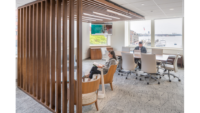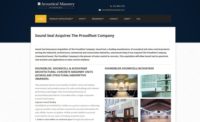Sight & Sound: CertainTeed’s New Headquarters

CertainTeed’s new headquarters boasts a stunning setting, LEED certification and a top-notch acoustics lab that showcase its versatile product lines.

CertainTeed’s new headquarters boasts a stunning setting, LEED certification and a top-notch acoustics lab that showcase its versatile product lines.

CertainTeed’s new headquarters boasts a stunning setting, LEED certification and a top-notch acoustics lab that showcase its versatile product lines.



Nestled on an extraordinary campus in Malvern, Pa. (just 30 miles outside Philadelphia), Saint-Gobain and its subsidiary CertainTeed Corp. set out to build a sustainable headquarters that focuses on the company’s many divisions’ product lines.
Strewn across a 65-acre site that retrofitted two existing four-story buildings joined by a four-story connecting link, the modern work place houses the company’s several divisions and top brass. Philadelphia architect Vincent Kling designed the structure originally for National Liberty Life Insurance in the early 1960s. The site had been unoccupied since 2009 while development was still underway for Saint-Gobain’s ambitious project.
On the outside, Greek-style amphitheaters can host company addresses, trails for pedestrians, creeks and a newly developed community garden that the company has developed to help low income families with organic produce.
The inside is very modern, with a large cafeteria where company events are held, a state-of-the-art gym, Starbucks and other attractive features designed to inspire. The company took on the challenge of converting the outdated facility, constructed primarily of curtainwall and exposed steel, into office space that was comfortable for workers, eligible for the highest levels of LEED certification and designed to function as a “living laboratory” where the performance of its products could be measured and evaluated on an ongoing basis.
Built for Comfort
Saint-Gobain was excited to showcase CertainTeed brands throughout the new facility. One of the biggest design questions was how to optimize thermal management in an open-plan office space encased in walls of glass.
Project Team
The E. Kahn Development Corp. and J. Loew & Associates, Inc., in collaboration with the AEGON USA Realty Advisors LLC, led the headquarters redesign project. The design team included Bernardon (core and shell architect); Jacobs (interior designer); and D. Fickler Construction LLC (general contractor). Additional support was provided by local sustainability consulting firms including The Sheward Partnership, Jacobs and Sustainable Solutions Corp.
Using sustainable insulation as a thermal break between the new curtainwall frame and the existing building structure, as well as maximizing the thermal resistance of opaque wall areas, allows the building to resist heat flow to the greatest extent possible. Furthermore, the insulation does not contribute particulates or VOCs to the interior environment, helping the structure reach its air quality—as well as thermal—performance goals. It also contributes to better acoustics by helping reduce sound transmission between rooms.
Sound Experience
Saint-Gobain’s new headquarters is more than just a showcase for innovative design; it’s also an opportunity to test and evaluate the performance of its products in an actual work environment.
One example of this showcase is the Acoustics Lab, an enhanced simulations room that can demonstrate the acoustics and sound in different environments. Led by its team of building scientists, Saint-Gobain worked with with Dr. Ihab Elzeyadi of the University of Oregon to assess the impact of the building’s design on the occupant experience, measuring factors such as indoor air quality and as well as thermal, acoustical and visual comfort. The lab’s primary staff includes Bob Marshall (Ceiling’s Marketing, Manager Technical Services) and Stan Gatland (CertainTeed R&D Platforms, Manager Building Sciences and Comfort) who can demonstrate the space.
“Our goal is to take measurements, gauge employees’ experience and comfort levels and then adjust the building accordingly to make it a better environment,” says Gatland.
An existing work room on the fourth floor of the Malvern HQ was retrofitted to be an auralization demonstration space to provide acoustic experiences to customers.
The lab is framed with high-performance products to eliminate outside sounds and internal reverberation and features strategically placed speakers for a 360-degree listening experience to model unique situations that occupants might encounter in various areas within open office environments. This enables architects and designers the real-time ability to hear what a specific design will sound like prior to construction.
The lab allows people to experience the cause and effect of different acoustic solutions in a virtual space. The lab tests the human listening experience within a defined area before it is even built, allowing specifiers to better understand the materials needed to provide an acoustically sound space. The participant can click on different solutions and evaluate their actual perception of the difference each material makes.
The Acoustics Lab is an experience that can help specifiers design on an auditory level. It is a virtual demonstration sound modeling tool that lets the specifier hear how design, materials and product specifications can affect the acoustics of a space. The Lab enables the participant to actually hear what a specific design will sound like before it is built.
Sound Lab Ingredients
Several of CertainTeed’s products were used for the lab. All partition walls were air sealed and extend to the underside of the roof deck. Materials in the space includes:
- CertainTeed SilentFX Noise-Reducing Drywall (partition wall)
- CertainTeed Sustainable Insulation (partition wall)
- Ecophon Texona Fiberglass Wall Panels (wall surface solution)
- CertainTeed Symphony m Mineral Fiber Panels (primary acoustical ceiling)
- CertainTeed Adagio Fiberglass/Mineral Fiber Composite Panels (acoustical ceilings below water source heat pump units to block mechanical noise)
- CertainTeed Classic Stab 15/16-inch Suspension System
- CertainTeed ToughGard TGR Rotary Duct Liner
The lab was developed by CertainTeed’s Building Science team in conjunction with architectural acoustics consultants at Acentech in Cambridge, Mass.
“Sound control is challenging because there really isn’t one way to solve it and how you control it is different depending on what you are trying to do,” says Gatland. “In fact, when we get inquiries about sound control, our first response is typically along the lines of ‘What are you trying to do?’ or ‘What problem are you trying to solve?’ Once we understand the problem, we can then begin to design solutions to meet the customer’s needs.
“For example, in the case of room acoustics, you want to absorb and reduce sound as it travels within a space; however, when we talk about sound transmission, we are trying to manage the amount of sound that is traveling through a wall from one space to another,” he continues. “While many other factors do need to be considered, lightweight fiberglass insulation is an excellent acoustical insulation material and is a critical component to achieving the sound rating targets of most wall systems as it adds up to 12 STC points depending on the type of assembly.”
“It really is a living, learning laboratory,” says Marshall. “If something doesn’t work, we can go back and change it based on the occupant experience.”
Sound Decisions
One of the project’s biggest challenges was acoustics. Both wall and ceiling systems were designed to minimize sound transmission in open areas.
In addition to the insulation’s sound controlling properties, CertainTeed’s acoustical experts also devised a two-part ceilings solution that offers excellent sound absorption: Ecophon Symphony f fiber glass ceiling panels and Adagio mineral/fiberglass hybrid ceiling panels. For surrounding huddle rooms and smaller meeting rooms, Symphony m mineral ceiling panels were selected.
To manage sound in the towering main entryway, Decoustics Claro custom ceiling panels, installed with a Ceilencio ceiling suspension system, are paired with the company’s custom wood wall panels. Claro Ceilencio horizontal fiber glass ceiling panels feature a curved shape that mimics the contours of the building’s exterior façade.
“Occasionally, the desire to showcase certain products was trumped by the need for specific acoustic performance,” says Marshall. “The opposite also occurred. In the end, it’s great to be able to evaluate an actual built environment and see how it aligns with the theoretical foundations of our product line.”
There were plenty of different CertainTeed and Saint-Gobain products specified throughout the facility to showcase how well these products can be used in office and commercial space.
“The contractors were surprised at all the different products we were having installed in the same space. They didn’t understand the benefits and wondered why we couldn’t just use one or two panel types,” says Marshall.
But Saint-Gobain and CertainTeed were intent on maximizing acoustic performance in the new facility. “Education is key,” Marshall continues, “Once the contractors saw the difference using the various tiles made in the acoustics of the space, they totally got it.”
Wall systems were also chosen with an ear toward acoustic performance. On the upper floors, area separation walls that surround meeting spaces feature SilentFX noise reducing drywall, which sandwiches a viscoelastic polymer between two dense gypsum cores, reducing sound transmission by as much as 75 percent when the board is used on both sides of the wall assembly, as was done in Malvern.
Plenty more can be said regarding the Malvern headquarters. Certainly, Saint-Gobain/CertainTeed put a lot of spirit and ambition into the design of this impressive facility. Their efforts should be applauded in achieving Double Platinum LEED status and creating a working space that demonstrates how the products look and work. Nice.
Looking for a reprint of this article?
From high-res PDFs to custom plaques, order your copy today!








